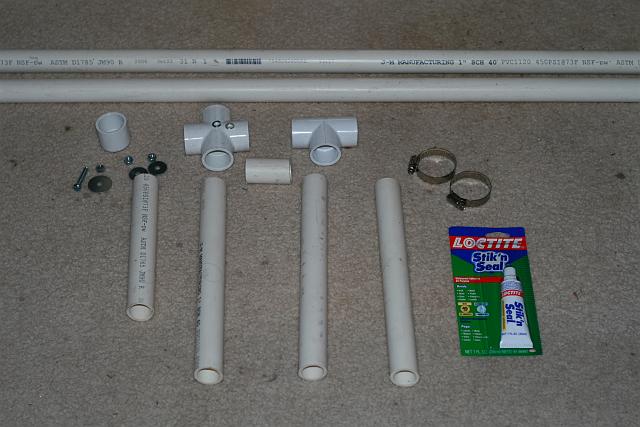
When I began to develop an interest in portrait photography, it didn't take me long to realize that I needed better control of my lighting. Following the suggestions of The Strobist (David Hobby), I chose to start with off-camera flash units, which are portable, flexible, and inexpensive. However, I needed a way to put the flashes in certain places. The right solution to that problem is to buy a light stand. However, at the time I wasn't certain I would pursue the interest long enough to justify such an investment, so I decided to build a light stand on the cheap.
What I came up with was a stand made out of that old standby, PVC piping. It provides sturdy support for a flash with adjustable height, but does not currently allow you to change the angle of the flash (I have an idea that will probably work, but haven't scoured my garage for materials yet). The materials for a single light stand cost me about $13 (tax included). Two stands can easily be built for under $25.
I chose 1-inch (2,5 cm) tubing to work with. The smaller diameters seemed to be too flexible, while the larger ones were both heavier and more expensive. The 1-inch version gives a good compromise between rigidity and cost.
For each light stand you plan to build, cut one of your PVC pipes as follows. None of the measurements are critical, and none of the cuts need to be perfectly square.
From the second piece of pipe, cut your uprights. The upright for one stand is made from two equal-length sections of pipe. I chose to make my two stands of different heights so that I could have one light up high (e.g., for a hair light) and one lower (e.g., for fill). For my first stand, I cut my pipe exactly in half, winding up with two 5-foot (1.5m) sections. I made the second shorter, using 4-foot (1.2m) sections. This lets my taller stand reach higher than my ceiling, while my shorter one can reach above my head or below a short model's chin.
Finally, drill a 1/4-inch hole in the center of the pipe cap. (I don't know metric drill sizes, but the hole needs to be large enough for the machine screw to pass through. It won't hurt if it's a bit big.)
Clean off all burrs from drilling and sawing. I found that I could do this with my bare fingers.
I originally planned to glue my stands together; however, I have found that a friction fit is enough and gives me flexibility. If you decide to glue things, just be sure that your two tees (see below) are aligned precisely. WARNING WARNING WARNING: The glue sold for PVC pipe is nasty, nasty stuff. It will pass right through your skin. A friend got some on his arm and was dizzy for hours. You don't need PVC glue for this project, but if you use it, be sure to wear heavy rubber gloves and treat it like plutonium. My own recommendation is to use a milder plastic glue, such as Loctite, or not to glue at all.
To assemble your light stand:
To use your light stand, attach your flash unit's tripod mounting hole to the machine screw on the top of the stand. Don't tighten it too much or you'll damage the flash. Instead, turn the nut that is glued to the fender washer until it is snug against the flash unit and provides a solid mounting surface.
To change the height of your light, simply slide the vertical pipe up and down. If necessary, adjust the tension of the two pipe clamps to make sliding easy. I found that the screw slots in the clamps are large enough to use a coin for this purpose. Be careful that neither pipe clamp slips off the end of the pipe.
To rotate the light, you will need to pick up the entire stand and turn it. (Alternatively, you can rotate the tripod mount on the machine screw, but I don't recommend this approach.) To tilt the light, you'll have to use its built-in tilting facilities. To this end, I found my cheap Chinese wireless receiver invaluable, since it incorporates a tilt facility. By tilting forward 45 degrees, I could use my flash unit's tilting and rotating head to achieve any angle I needed.
I haven't tested my stand's weight limits. It does fine with portable flash units like the Canon 580EX or the Sigma EF-500 Super. If you try it with studio lights, do so at your own risk.
I'm planning on adding a tilt facility to my light stand by using two "L" brackets, two more machine screws, a thumbscrew, and a rubber washer for friction. If I can make that work, I'll revise this page.
The big missing item in my design is the lack of an umbrella mount. Since I don't have any umbrellas, I don't have good ideas for how to add a mount to my design.
This page is maintained by Geoff Kuenning.